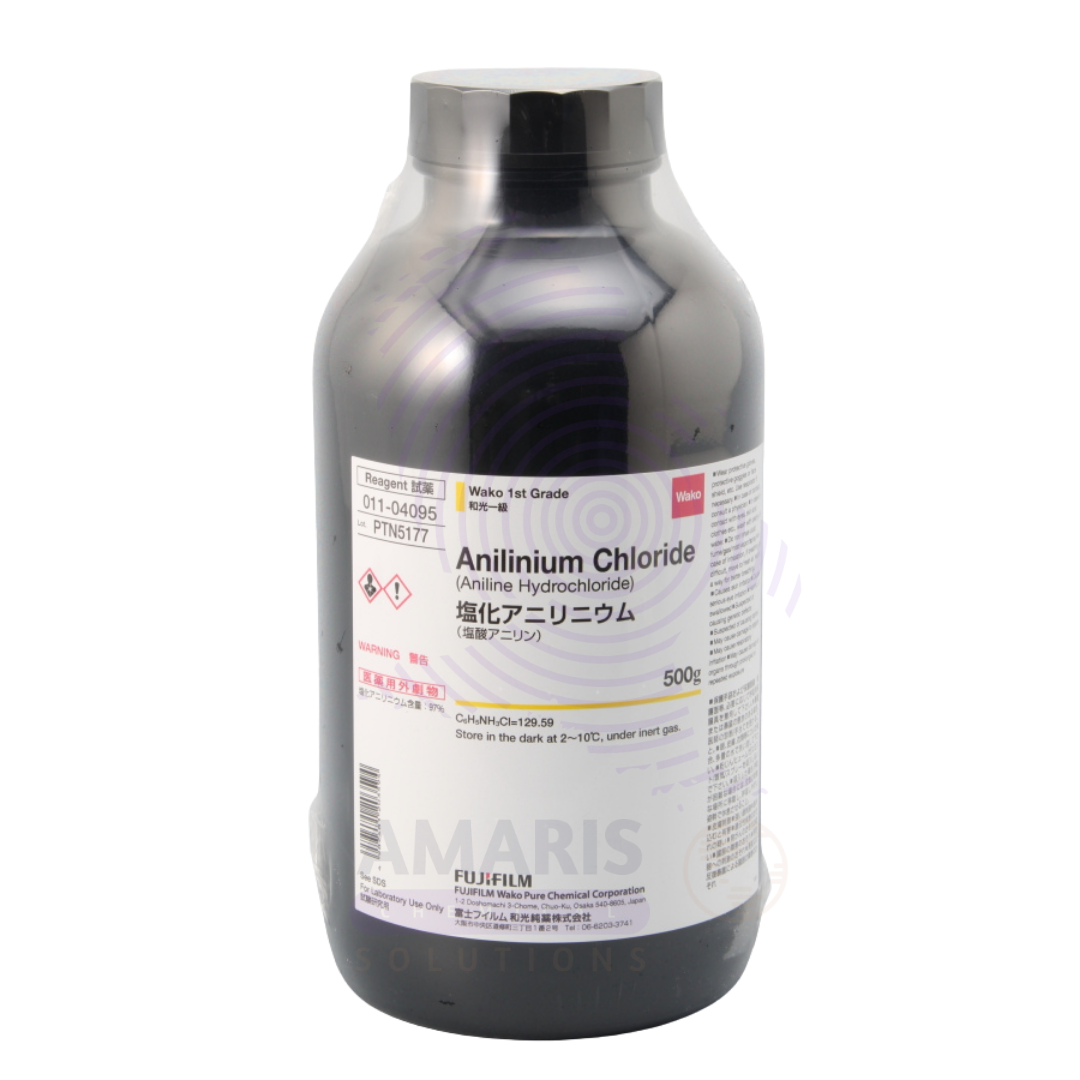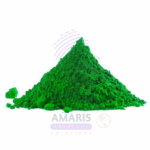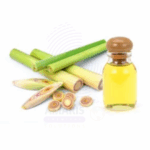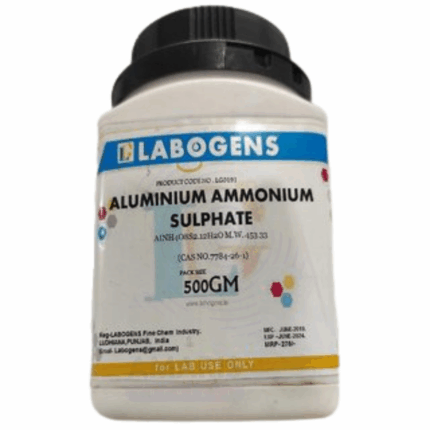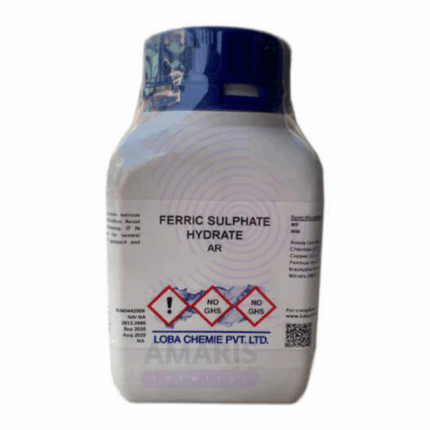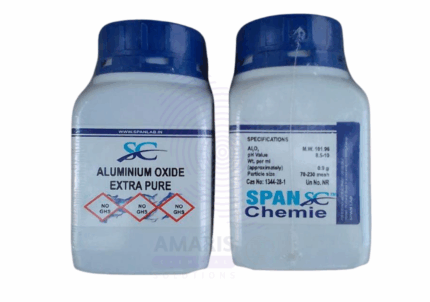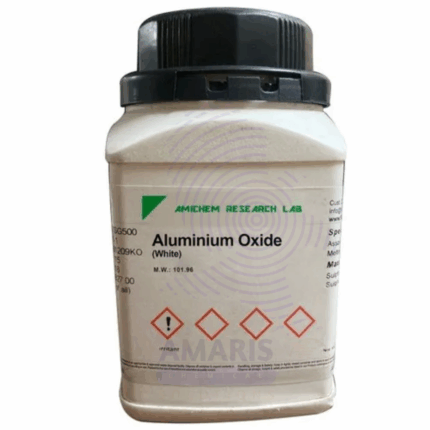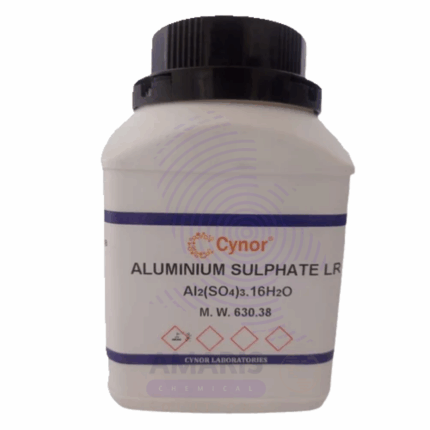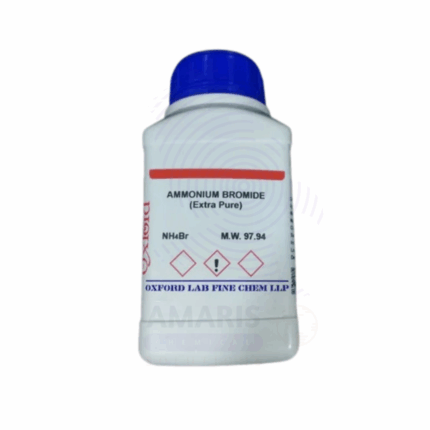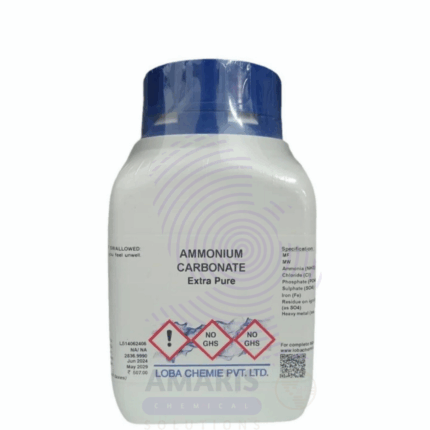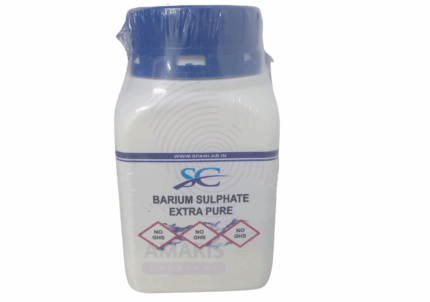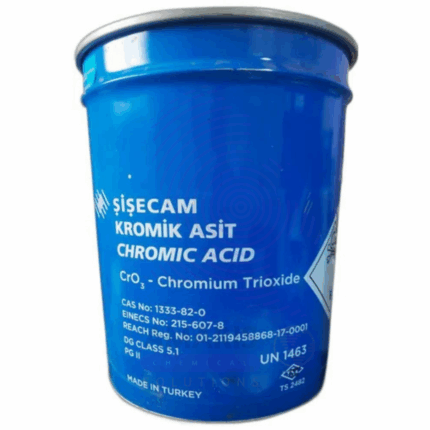Anilium Chloride Extra Pure
$ 19.00 Original price was: $ 19.00.$ 18.77Current price is: $ 18.77.
Anilium Chloride Extra Pure is a high-purity, white to off-white crystalline salt formed from aniline and hydrochloric acid, commonly used in laboratory chemistry for organic synthesis and analytical applications. It serves as a stable, water-soluble source of the anilinium ion, useful in studies of aromatic amines, protonation reactions, and acid-base equilibria. In synthetic chemistry, it acts as an intermediate in the preparation of dyes, pharmaceuticals, and polymer additives. The extra pure grade ensures minimal impurities, making it suitable for sensitive experimental procedures requiring high precision. It should be stored in a tightly sealed container in a cool, dry place to maintain stability and prevent degradation.
Anilium Chloride Extra Pure
Primary Uses
- Intermediate in the Synthesis of Dyes and Aromatic Compounds
- Acts as a protected form of aniline, used in the controlled synthesis of azo dyes, quinolines, and other aromatic derivatives.
- Reagent in Acid–Base Equilibria and pKa Studies
- An excellent model compound for teaching weak base–strong acid salt behavior and calculating pKa/pKb in buffer systems.
- Precursor for Aniline Regeneration
- Easily converted back to aniline (C₆H₅NH₂) via base treatment, useful in stepwise syntheses where temporary protonation is needed.
- Demonstration of Aromatic Ammonium Salt Properties
- Ideal for educational labs illustrating protonation of amines, hydrogen bonding, and infrared/NMR spectral changes upon salt formation.
- Model Compound in Organic Mechanistic Studies
- Studied for its role in protonation equilibria, electrophilic aromatic substitution, and reaction kinetics in undergraduate and research labs.
Secondary Uses
- Starting Material for Anilinium-Based Ionic Liquids
- Occasionally used in research to prepare low-melting salts or ionic liquids for green chemistry and electrochemical studies.
- Reagent in Electrochemical and Conductivity Studies
- Useful for studying the conductivity of substituted ammonium salts in various solvents.
- Teaching Crystallization and Salt Characterization
- A stable, crystalline compound that demonstrates melting point determination, recrystallization, and elemental analysis.
- Source of Weak Acid Cation in Ion Exchange Research
- Studied in ion exchange systems or chromatographic methods for separating aromatic amines.
- Control Compound in Aromatic Substitution Pathway Experiments
- Used to observe the effect of protonation on nucleophilic and electrophilic behavior in substituted benzenes.
| PACK SIZE |
100 grams Plastic Tin |
|---|
1. Basic Identification Attributes
- Chemical Name: Anilinium Chloride
- CAS Number: 3724-65-0
- HS Code: 29214200 (Aniline derivatives)
- Molecular Formula: C₆H₈ClN
- Synonyms:
- Aniline hydrochloride
- Anilinium chloride
- Benzenamine hydrochloride
- Phenylammonium chloride
2. Physical & Chemical Properties
- Physical State: Solid (crystalline powder)
- Color & Odor: White to pale yellow; slight amine-like odor
- Boiling Point: Decomposes before boiling
- Melting Point: ~198–203 °C
- Density/Specific Gravity: ~1.22 g/cm³
- Solubility:
- Water: Freely soluble
- Ethanol: Slightly soluble
- pH Level: Acidic in aqueous solution (~pH 3–4)
- Vapor Pressure: Negligible (non-volatile solid)
- Flash Point: Not applicable (non-flammable)
- Autoignition Temperature: Not applicable
- Viscosity: Not applicable
3. Safety & Hazard Attributes
- Hazard Class (GHS):
- Acute Toxicity – Oral (Category 4)
- Skin Irritation (Category 2)
- Eye Irritation (Category 2A)
- NFPA Ratings:
- Health: 2
- Flammability: 0
- Reactivity: 0
- Exposure Limits:
- No established OSHA/ACGIH limits for anilinium chloride specifically
- Handle with standard protective lab gear
- Reactivity:
- Stable under normal lab conditions
- Incompatible with strong oxidizing agents and strong bases
4. Storage & Handling Attributes
- Storage Conditions:
- Store in tightly sealed containers in a cool, dry place
- Protect from light and moisture
- Incompatible Materials:
- Oxidizing agents, strong alkalis
- Container Type:
- Amber glass or plastic container with desiccant
- Shelf Life & Expiration Date:
- ~2–3 years if stored properly
- Special Handling Requirements:
- Use gloves, goggles, and dust mask
- Handle under fume hood if heated or used in large amounts
5. Regulatory & Compliance Attributes
- Regulatory Status:
- Listed in TSCA and under REACH
- Not commonly regulated for transport in small lab quantities
- Transportation Restrictions:
- Not classified as hazardous for transport
- Waste Disposal Method:
- Dispose as hazardous organic waste
- Do not pour into drain or mix with oxidizers
6. Environmental & Health Impact
- Ecotoxicity:
- Toxic to aquatic organisms in high concentrations
- Persistence in Environment:
- May undergo slow degradation
- Carcinogenicity/Mutagenicity:
- Not classified, but aniline (parent compound) is a suspected carcinogen
- Biodegradability:
- Slowly biodegradable
SAFETY PRECAUTIONS
- Personal Protective Equipment (PPE):
- Wear a lab coat, chemical-resistant gloves (nitrile or neoprene), and safety goggles.
- Use in a fume hood to prevent inhalation of vapors or dust.
- Handling:
- Avoid inhalation, ingestion, and contact with skin or eyes.
- Prevent formation of dust and avoid exposure to heat, light, and strong oxidizers.
- Ensure containers are kept tightly closed and handled with non-sparking tools.
- Storage:
- Store in a cool, dry, and well-ventilated area.
- Keep container tightly sealed and protected from light and moisture.
- Store away from oxidizing agents, acids, and strong bases.
- Hygiene Measures:
- Wash hands thoroughly after handling.
- Do not eat, drink, or smoke in the lab.
- Decontaminate equipment and surfaces after use.
FIRST AID MEASURES
- Inhalation:
- Move person to fresh air immediately.
- If breathing is difficult, administer oxygen.
- Seek immediate medical attention—may cause respiratory tract irritation or CNS effects (like dizziness or headache).
- Skin Contact:
- Rinse skin with plenty of soap and water.
- Remove contaminated clothing and wash before reuse.
- Seek medical advice—aniline derivatives can be absorbed through skin and affect blood oxygenation.
- Eye Contact:
- Rinse cautiously with plenty of water for at least 15 minutes.
- Hold eyelids apart and remove contact lenses if present.
- Seek immediate medical attention—may cause corneal irritation.
- Ingestion:
- Rinse mouth thoroughly.
- Do not induce vomiting.
- Give water to dilute if the person is conscious.
- Seek immediate medical attention—anilinium compounds can cause methemoglobinemia, leading to oxygen transport issues.
FIRE FIGHTING MEASURES
- Suitable Extinguishing Media:
- Use dry chemicals, CO₂, alcohol-resistant foam, or water spray.
- Specific Hazards:
- Not highly flammable, but upon heating or fire may release:
- Toxic fumes of nitrogen oxides (NOₓ)
- Hydrogen chloride (HCl)
- Aniline vapors
- Not highly flammable, but upon heating or fire may release:
- Protective Equipment for Firefighters:
- Wear self-contained breathing apparatus (SCBA) and full protective gear.
- Firefighting Instructions:
- Use water spray to cool exposed containers.
- Avoid breathing vapors or decomposition products.
- Prevent firefighting runoff from entering drains or watercourses.
Related products
Aluminium Ammonium Sulphate Extra Pure
Aluminium Ferric Sulphate Extra Pure
Aluminium Oxide Extra Pure
Aluminium Sulphate Anhydrous Extra Pure
Ammonium Bromide Extra Pure
Ammonium Carbonate Extra Pure
Ammonium Carbonate Extra Pure is a high-quality, white crystalline solid widely used across various scientific, industrial, and food-related applications. Manufactured to stringent purity standards, this compound is ideal for laboratories and processes that demand high-grade reagents. With its characteristic ammonia-like odor and ability to decompose upon heating, ammonium carbonate plays a versatile role in both chemical reactions and physical processes.
In aqueous solution, ammonium carbonate breaks down into ammonium bicarbonate and ammonium carbamate, further releasing ammonia (NH₃) and carbon dioxide (CO₂) upon heating. This property makes it especially useful in applications that require controlled gas release or temporary pH modification.


 Preservatives(food)
Preservatives(food) Flavor Enhancers
Flavor Enhancers Acidulants
Acidulants Sweeteners
Sweeteners Antioxidants
Antioxidants Colorants(food)
Colorants(food) Nutraceutical Ingredients (food)
Nutraceutical Ingredients (food) Nutrient Supplements
Nutrient Supplements Emulsifiers
Emulsifiers
 Collectors
Collectors Dust Suppressants
Dust Suppressants Explosives and Blasting Agents
Explosives and Blasting Agents Flocculants and Coagulants
Flocculants and Coagulants Frothers
Frothers Leaching Agents
Leaching Agents pH Modifiers
pH Modifiers Precious Metal Extraction Agents
Precious Metal Extraction Agents
 Antioxidants(plastic)
Antioxidants(plastic) Colorants (Pigments, Dyes)
Colorants (Pigments, Dyes) Fillers and Reinforcements
Fillers and Reinforcements Flame Retardants
Flame Retardants Monomers
Monomers Plasticizers
Plasticizers Polymerization Initiators
Polymerization Initiators Stabilizers (UV, Heat)
Stabilizers (UV, Heat)
 Antifoaming Agents
Antifoaming Agents Chelating Agents
Chelating Agents Coagulants and Flocculants
Coagulants and Flocculants Corrosion Inhibitors
Corrosion Inhibitors Disinfectants and Biocides
Disinfectants and Biocides Oxidizing Agents
Oxidizing Agents pH Adjusters
pH Adjusters Scale Inhibitors( water)
Scale Inhibitors( water)
 Antioxidants(cosmetic)
Antioxidants(cosmetic) Emollients
Emollients Fragrances and Essential Oils
Fragrances and Essential Oils Humectants
Humectants Preservatives
Preservatives Surfactants(cosmetic)
Surfactants(cosmetic) Thickeners
Thickeners UV Filters
UV Filters
 Fertilizers
Fertilizers Soil Conditioners
Soil Conditioners Plant Growth Regulators
Plant Growth Regulators Animal Feed Additives
Animal Feed Additives Biostimulants
Biostimulants Pesticides (Herbicides, Insecticides, Fungicides)
Pesticides (Herbicides, Insecticides, Fungicides)
 Active Pharmaceutical Ingredients (APIs)
Active Pharmaceutical Ingredients (APIs) Excipients
Excipients Solvents(pharmaceutical)
Solvents(pharmaceutical) Antibiotics
Antibiotics Antiseptics and Disinfectants
Antiseptics and Disinfectants Vaccine Adjuvants
Vaccine Adjuvants Nutraceutical Ingredients (pharmaceutical)
Nutraceutical Ingredients (pharmaceutical) Analgesics & Antipyretics
Analgesics & Antipyretics
 Analytical Reagents
Analytical Reagents Solvents(lab)
Solvents(lab) Chromatography Chemicals
Chromatography Chemicals Spectroscopy Reagents
Spectroscopy Reagents microbiology-and-cell-culture-reagents
microbiology-and-cell-culture-reagents Molecular Biology Reagents
Molecular Biology Reagents Biochemical Reagents
Biochemical Reagents Inorganic and Organic Standards
Inorganic and Organic Standards Laboratory Safety Chemicals
Laboratory Safety Chemicals Specialty Laboratory Chemicals(Special Laboratory Equipment)
Specialty Laboratory Chemicals(Special Laboratory Equipment)
 Demulsifiers
Demulsifiers Hydraulic Fracturing Fluids
Hydraulic Fracturing Fluids Scale Inhibitors(oil)
Scale Inhibitors(oil) Surfactants(oil)
Surfactants(oil) Drilling Fluids
Drilling Fluids
 Dyes and Pigments
Dyes and Pigments Bleaching Agents
Bleaching Agents Softening Agents
Softening Agents Finishing Agents
Finishing Agents Antistatic Agents
Antistatic Agents
 Admixtures
Admixtures Waterproofing Agents
Waterproofing Agents Sealants and Adhesives
Sealants and Adhesives Curing Compounds
Curing Compounds Concrete Repair Chemicals
Concrete Repair Chemicals Anti-Corrosion Coatings
Anti-Corrosion Coatings
 Surfactants(cleaning)
Surfactants(cleaning) Builders
Builders Enzymes
Enzymes Solvents (Cleaning)
Solvents (Cleaning) Fragrances
Fragrances
 Electronic Chemicals
Electronic Chemicals Catalysts
Catalysts Lubricants
Lubricants Photographic Chemicals
Photographic Chemicals Refrigerants
Refrigerants Automotive chemicals
Automotive chemicals Pyrotechnic Chemicals
Pyrotechnic Chemicals
 Biodegradable Surfactants
Biodegradable Surfactants Bio-based Solvents
Bio-based Solvents Renewable Polymers
Renewable Polymers Carbon Capture Chemicals
Carbon Capture Chemicals Wastewater Treatment Chemicals
Wastewater Treatment Chemicals
 Pigments
Pigments Solvents(paint)
Solvents(paint) Specialty Coatings
Specialty Coatings Binders/Resins
Binders/Resins Additives
Additives Driers
Driers Anti-Corrosion Agents
Anti-Corrosion Agents Functional Coatings
Functional Coatings Application-Specific Coatings
Application-Specific Coatings
 Fresh Herbs
Fresh Herbs Ground Spices
Ground Spices Whole Spices
Whole Spices Spice Blends
Spice Blends Dried Herbs
Dried Herbs
 Leavening Agents
Leavening Agents Dough Conditioners
Dough Conditioners Flour Treatments
Flour Treatments Fat Replacers
Fat Replacers Decoratives
Decoratives Preservatives(baking)
Preservatives(baking)
 Plasticizers & Softeners
Plasticizers & Softeners Reinforcing Agents
Reinforcing Agents Adhesion Promoters
Adhesion Promoters Vulcanizing Agents
Vulcanizing Agents Antidegradants
Antidegradants Blowing Agents
Blowing Agents Fillers & Extenders
Fillers & Extenders Accelerators & Retarders
Accelerators & Retarders